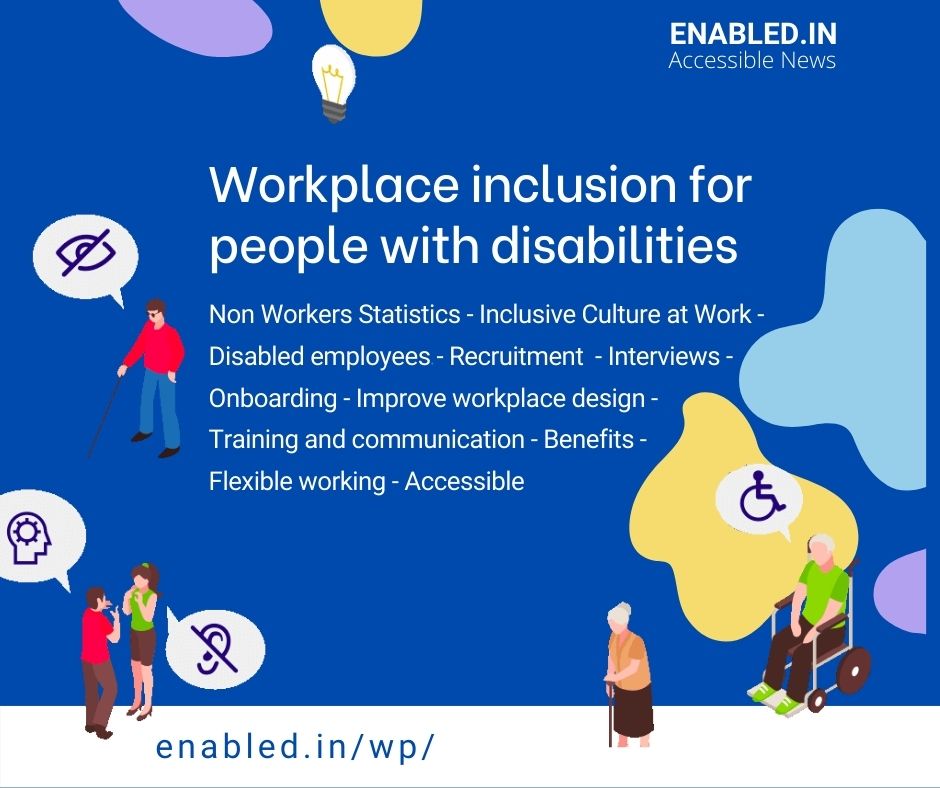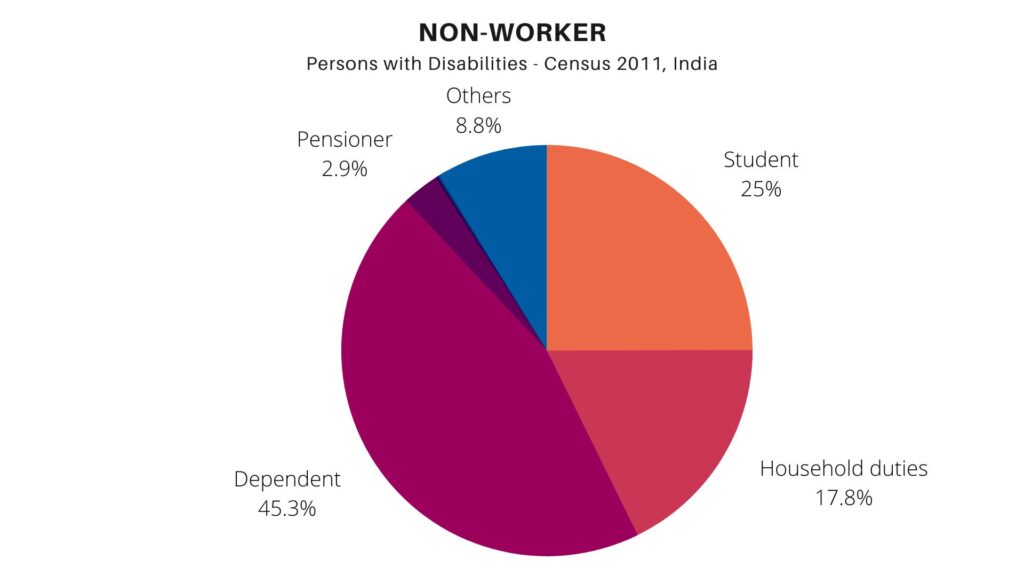Complete guide for disability inclusion: A comprehensive guide to workplace inclusion for people with disabilities.
This guide focuses on the key aspects of disability in the workplace, including a look at how inclusive company policies and working styles tend to be (or aren’t).

We’ll also look at what methods companies can use to ensure a more inclusive culture. By making disability inclusion a priority, businesses can help drive motivation, engagement, and talent retention at work.
Disability inclusion in the workplace
Having a job or career is a standard part of life for many people, but there can be barriers in place that make it difficult for a person with disabilities to find and retain employment. Taking an inclusive stance can increase workplace opportunities.
Persons with Disabilities – Non Workers Statistics
According to the Census 2011, India, 17070608 Persons with disabilities have no jobs, Now its may be increased…
| Activity of Non-worker | Persons | Male | Female |
| Total | 17070608 | 7915768 | 9154840 |
| Student | 4638653 | 2637330 | 2001323 |
| Household duties | 2618327 | 223567 | 2394760 |
| Dependent | 7807540 | 3954788 | 3852752 |
| Pensioner | 947169 | 525191 | 421978 |
| Rentier | 37492 | 22687 | 14805 |
| Beggar, Vagrants,etc. | 70506 | 43141 | 27365 |
| Others | 950921 | 509064 | 441857 |

Inclusion?
People with disabilities are given the same opportunities to engage in society as other people through inclusion.
Inclusion should ideally be a significant component of workplace rules and practises, going beyond simply encouraging employees to do so.
However, there’s still progress to be made. The disability employment gap was greater for disabled men than disabled women. Interestingly, this is the opposite of the trend for non-disabled people, amongst whom men are more likely to be in work.
| Non Worker Age Group | Persons | Male | Female |
| Total | 17070608 | 7915768 | 9154840 |
| 0-14 | 5344297 | 2942702 | 2401595 |
| 15-59 | 7785245 | 3317990 | 4467255 |
| 60+ | 3854887 | 1614909 | 2239978 |
| Age not stated | 86179 | 40167 | 46012 |
The same report noted that the disability employment gap increases for disabled people aged between 15-59 and 60+ years . One reason for this is that a higher percentage of all people across this age group have disabilities. Increased health risks, such as disease, injury and chronic illness, all contribute towards higher disability rates in the older population.
Creating a more Inclusive Culture at Work
Supporting disabled employees
The good news is that the majority of employers are open to creating a more supportive environment for disabled candidates and employees.
It will also benefit your company in the long-run. Employee retention is likely to be higher if your team is happy and supported.
Change the language you use
The disabled community may have differing views on some terms. Always ask a disabled employee what they prefer, and be willing to update your vocabulary as language shifts. Doing so will help to create a more welcoming working environment.
Recruitment
Job posts
Consider using other methods in addition to your usual recruitment sites or agencies. Reach out to non-profit organisations, employment programs for people with disabilities, and local universities or colleges, or hire a recruitment agency that supports people with disabilities. This will widen the net when you’re looking for new employees. The process should be in Accessible.
Interviews
Every candidate will need to know about the interview process well in advance. This gives people with disabilities time to ask for reasonable adjustments, such as extra time to complete a task, or a sign language interpreter. It’s also important to remember that not all disabilities can be seen. Give every applicant and new hire the opportunity to inform you of their needs.
Onboarding
Ask them which reasonable adjustments will need to be made. A disabled employee may need additional technology to do their job, such as a screen reader or specific type of keyboard, and they may need to work flexible hours, or from home.
Improve workplace design and accessibility
- Widening doorways and other entrances
- Providing ramps for wheelchair users
- Providing larger computer screens
- Making sure plug sockets are safely in reach
- Providing assistive technology, such as screen readers, magnifiers, and keyboards
- Clearing trip hazards out of the way
Flexible working
As defined by the charity Scope, flexible working is “a way of working that suits an employee’s needs.” This could be flexible start and finish times, the option to work from home, condensing work days, taking more breaks, or not having to travel during peak commuter hours.
Acceptable reasons for turning down a flexible working request include:
- Additional costs
- Being unable to meet customer demand
- Being unable to recruit additional employees
- Being unable to reorganise work amongst other employees
- Impact on performance and/or quality
- A planned change to the business structure
Training and communication
Your non-disabled employees should be aware of the steps you’re taking towards disability inclusion, why they’re important, and what they can do to accommodate disabled members of the team. Clear communication needs to come from the top down, setting the tone for all employees. This will help everyone feel enthusiastic and lend their support.
The benefits of inclusive workplaces
- Access to talent – By focusing on skills rather than stereotypes, you access an untapped pool of talent.
- Increased innovation – Employees with diverse experiences have different approaches to problem solving.
- Increased engagement and retention – Employees who feel included have higher levels of loyalty and enthusiasm.
- Better reputation – Customers value companies that show a real commitment towards inclusion.
- Benefits for everyone – Everyone benefits from an inclusive workplace, not just those with a disability.
Focus on Disabilities inclusion initiatives and include
- Enhancing the Enviormental accessibility in its Colleges and Traning Institutions across India
- Ensuring Universal accessibility guidelines
- All Job and Traning Information should be Accessible.
- Running and driving accessible awareness programs and events.
Conlusion
Employers have a variety of options when it comes to being more inclusive at work, including educating employees about unconscious prejudice and making offices more accessible.
Overall, it leads to more employment prospects for people with disabilities and, in the long run, a happier, more supportive, and more devoted team. However, it will require some additional work and a willingness to adjust some policies and procedures.
Author Bio…
Sathasivam Kannupayan
Specialist in Digital Accessibility & Environment
Phone : +91 9840 515 647
Email : sathasivam@enabled.in
ref:
https://censusindia.gov.in
https://www.thanksben.com/the-definitive-guide-to-disability-inclusion-in-the-workplace
